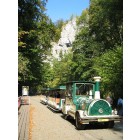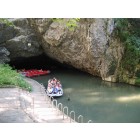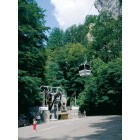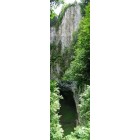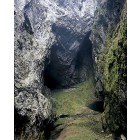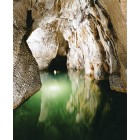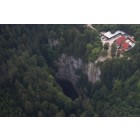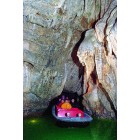The Macocha Abyss is the largest abyss of its type in Central Europe. Since 1914, the bottom of the abyss has been an integral part of the tour of the publicly accessible Punkva Caves. The abyss itself is also accessible to the public. Visitors can view the abyss from two observation platforms. The upper observation platform at a height of 138 metres above the bottom of the abyss, and the lower observation platform at a height of around 90 metres from the bottom. The starting point for a visit to both observation platforms is the paid car park around 200 metres from the abyss. The embarkation point for the cableway leading to the Punkva Caves is not far from the upper observation platform. A picturesque footpath leads from the lower observation platform to the Punkva Caves.
The abyss itself was in all probability formed by the caving in of the weakened roof of an enormous underground chamber through which the subterranean River Punkva ran. The joining of the karst depression on the surface with the cave opened up a vertical cavity that is today 138.5 metres deep. The vast dimensions of the abyss mean that the whole area is exposed to daylight, making it a “light hole” type of abyss in the karst classification. This is also reflected in its climatic and vegetational conditions. The subterranean River Punkva, which flows along the bottom of the abyss, is formed by the confluence of a large number of subterranean chutes running through the limestone area from the north and east and joining up in the cave complex of the Amateur Caves (their known passageways exceed 30 kilometres in length). The most important are the Sloup Stream and Bílá Voda (White Water). The Macocha Abyss is separated from the Amateur Caves by a system of complicated siphons. Water from the Punkva flows into the abyss through Jalové Koryto (Barren Bed), plays a part in feeding Horní Jezírko (Upper Lake – around 13 metres deep), and spills over into Dolní Jezírko (Lower Lake – around 40 metres deep). From here the water flows through siphons to Čtyřicítka (Forty – named after its original depth) and a headspring in Pustý Žleb.
There is an interesting history of exploration of the abyss. The inhabitants of the area knew of its existence in ancient times. The first written record of a human descent into Macocha comes from 1723, when Lazar Schopper, a monk from the Minorite monastery in Brno, had himself lowered into the abyss. After him, around twelve recorded descents were undertaken by the year 1900 which over the course of time took on the nature of specialist expeditions. These came to a climax with the discovery and opening of the dry part of the Punkva Caves (1909–1914) and the Macocha Water Chambers (1920–1933).
The upper observation platform was built by the Brno section of the Austrian Tourist Club in 1882. General repairs were performed to it by the Cave Administration of the Czech Republic – the Moravian Karst Cave Administration in June 2007. The lower observation platform was built in 1899. The Czech Tourist Club built a shelter near the upper observation platform in 1895. This later burned down, however, and was restored as the Macocha Cabin.
The abyss itself was in all probability formed by the caving in of the weakened roof of an enormous underground chamber through which the subterranean River Punkva ran. The joining of the karst depression on the surface with the cave opened up a vertical cavity that is today 138.5 metres deep. The vast dimensions of the abyss mean that the whole area is exposed to daylight, making it a “light hole” type of abyss in the karst classification. This is also reflected in its climatic and vegetational conditions. The subterranean River Punkva, which flows along the bottom of the abyss, is formed by the confluence of a large number of subterranean chutes running through the limestone area from the north and east and joining up in the cave complex of the Amateur Caves (their known passageways exceed 30 kilometres in length). The most important are the Sloup Stream and Bílá Voda (White Water). The Macocha Abyss is separated from the Amateur Caves by a system of complicated siphons. Water from the Punkva flows into the abyss through Jalové Koryto (Barren Bed), plays a part in feeding Horní Jezírko (Upper Lake – around 13 metres deep), and spills over into Dolní Jezírko (Lower Lake – around 40 metres deep). From here the water flows through siphons to Čtyřicítka (Forty – named after its original depth) and a headspring in Pustý Žleb.
There is an interesting history of exploration of the abyss. The inhabitants of the area knew of its existence in ancient times. The first written record of a human descent into Macocha comes from 1723, when Lazar Schopper, a monk from the Minorite monastery in Brno, had himself lowered into the abyss. After him, around twelve recorded descents were undertaken by the year 1900 which over the course of time took on the nature of specialist expeditions. These came to a climax with the discovery and opening of the dry part of the Punkva Caves (1909–1914) and the Macocha Water Chambers (1920–1933).
The upper observation platform was built by the Brno section of the Austrian Tourist Club in 1882. General repairs were performed to it by the Cave Administration of the Czech Republic – the Moravian Karst Cave Administration in June 2007. The lower observation platform was built in 1899. The Czech Tourist Club built a shelter near the upper observation platform in 1895. This later burned down, however, and was restored as the Macocha Cabin.


